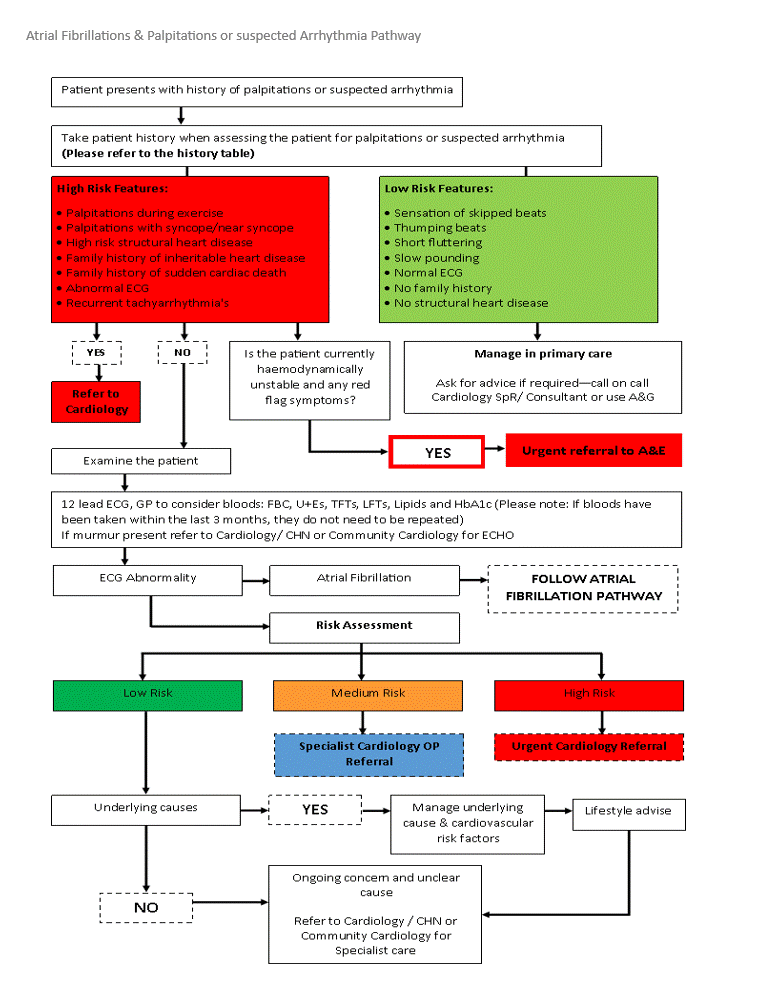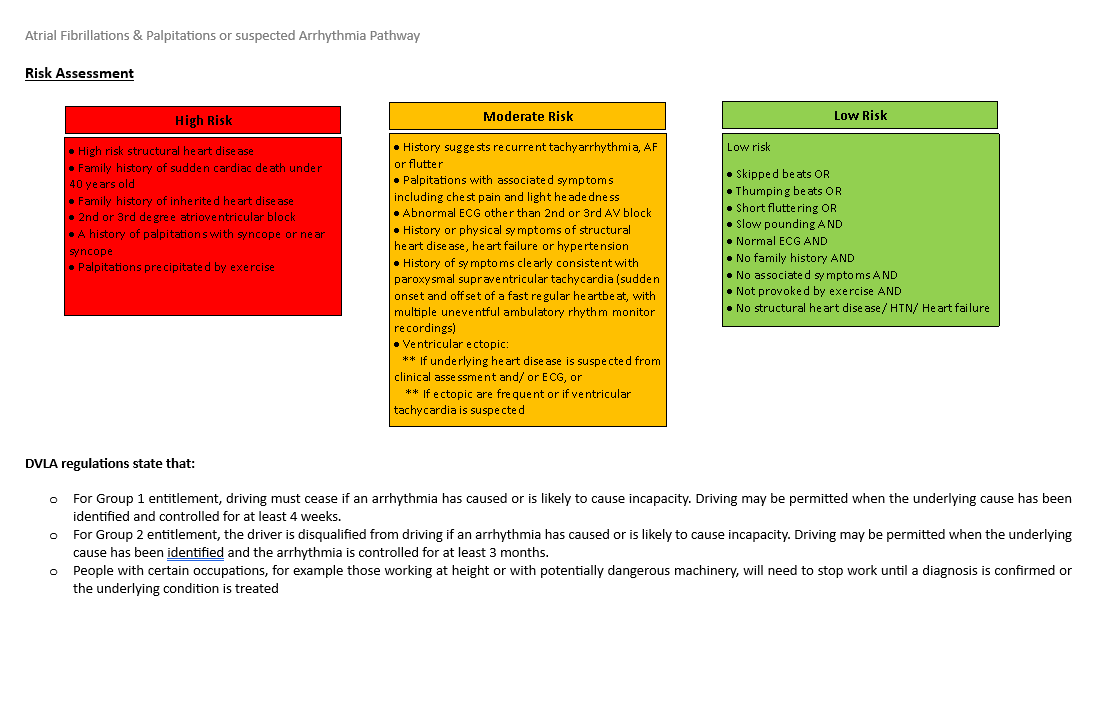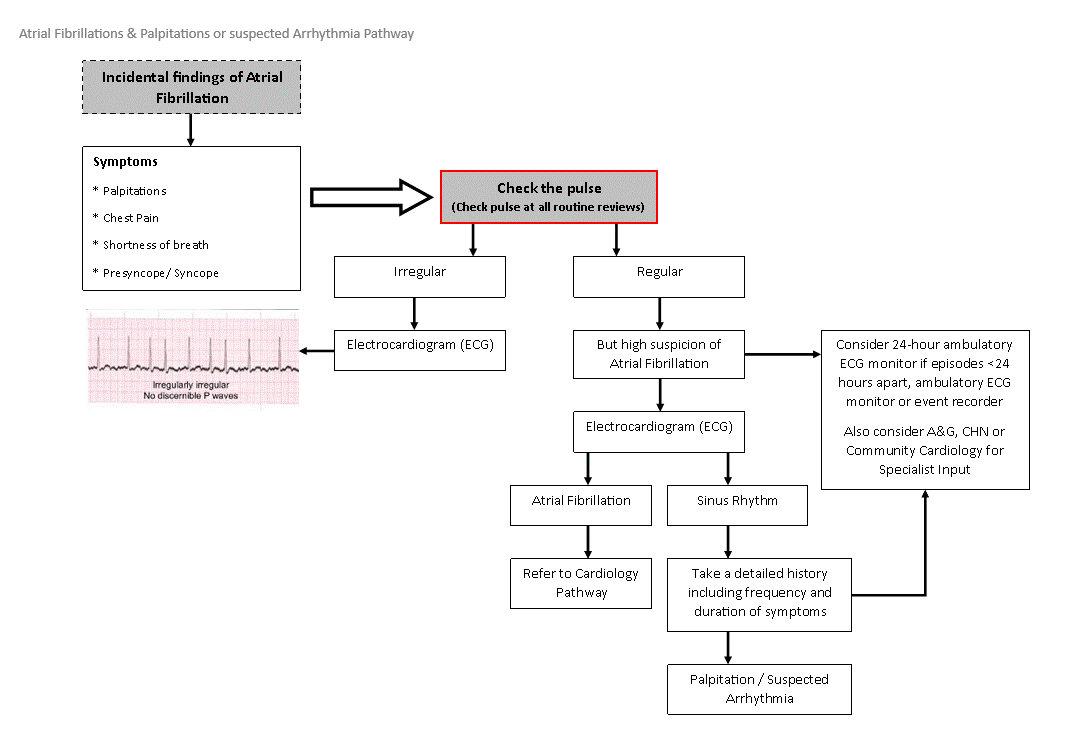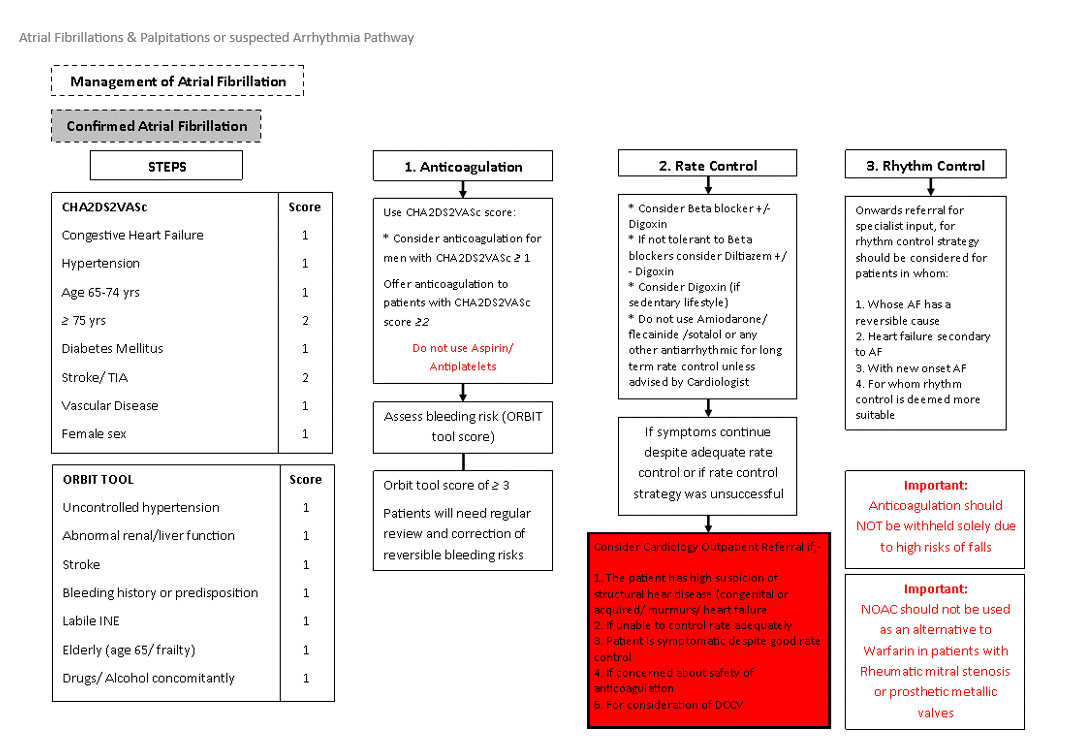CDC Combined AF and Palpatations (NL & NEL)
Definition/Description
History
When assessing for palpitations ask about:
- Onset
- Time of day
- Nature of palpitations - Onset/offset of symptoms e.g. gradual or precipitous, warning or no warning
- Frequency of symptoms: e.g. multiple daily/most days/1-2x month/very infrequently
- Duration of symptoms: seconds/minutes/longer
- Severity
- Associated symptoms
- Triggers
- Family history of sudden cardiac death <40 years
- Pre-existing cardiac condition and/ or history of heart disease, known cardiovascular diagnosis, Hypertension/Diabetes/CVA/TIA/IHD/MI/Cardiomyopathy
- Lifestyle factors – ETOH, nicotine, caffeine, illicit drug use
- Anxiety
- Past medical history - Unexplained dizziness/collapses/blackouts (syncope/presyncope/dizziness) To determine adequate rate control in atrial fibrillation, to determine if rhythm control has been achieved in paroxysmal atrial fibrillation, and to exclude potential dangerous ventricular arrhythmias in a number of conditions e.g. hypertrophic or dilatated cardiomyopathy, prolonged QT interval, severely reduced LV systolic function in IHD etc, and to look for asymptomatic AF in cryptogenic ischaemic CVA or TIA
- Medication history including b-blockers, antiarrhythmics, anticoagulants
- Presence of any other systemic causes
Red Flag Symptoms
Arrange emergency admission for a person with current palpitations and
- Ventricular tachycardia
- Persistent supraventricular tachycardia
- Haemodynamically unstable
- High risk structural heart disease including ischemic heart disease
- Features suggestive of a serious underlying cardiac cause or complication:
- Second- or third-degree atrioventricular block on ECG
- Significant breathlessness or any signs of respiratory distress
- Chest pain
- Syncope or near syncope
- Family history of sudden cardiac death or dangerous arrhythmia under the age of 40 years
- Onset of palpitations precipitated by exercise
Consider admission for a person with current palpitations and evidence of a serious or life-threatening systemic cause such as thyrotoxicosis, severe anaemia, or sepsis.
Atrial Fibrillation Stroke Risk Factors:
Use the CHA2DS2VASc stroke risk score to assess stroke risk in people with any of the following:
- Symptomatic or asymptomatic paroxysmal, persistent, or permanent atrial fibrillation
- Atrial flutter
- A continuing risk of arrhythmia recurrence after cardioversion back to sinus rhythm or catheter ablation
Atrial Fibrillation Bleeding Risk Factors:
Assess the risk of bleeding when:
- Considering starting anticoagulation in people with atrial fibrillation and
- Reviewing people already taking anticoagulation
- Use the ORBIT tool bleeding risk score because evidence shows that it has a higher accuracy in predicting absolute bleeding risk than other bleeding risk tools. Accurate knowledge of bleeding risk supports shared decision making and has practical benefits, for example, increasing patient confidence and willingness to accept treatment when risk is low and prompting discussion of risk reduction when risk is high. Although ORBIT is the best tool for this purpose, other bleeding risk tools may need to be used until it is embedded in clinical pathways and electronic systems. [2021]
Offer monitoring and support to modify risk factors for bleeding, including:
- Uncontrolled hypertension
- Poor control of international normalised ratio (INR) in patients on vitamin K antagonists
- Concurrent medication, including antiplatelets, selective serotonin reuptake inhibitors (SSRIs) and non-steroidal anti-inflammatory drugs (NSAIDs)
- Harmful alcohol consumption
- Reversible causes of anaemia
Guidelines on Management
Examination
Carry out an examination of the patient, to include:
Cardiovascular system:
- Heart rate and rhythm
- Blood pressure
- Heart sounds and murmurs suggestive of valvular disease
- Signs of a clinical feature of heart failure, raised JVP, lung sounds, peripheral oedema, gallop rhythm
Thyroid status examinations:
- Assessing for signs of thyrotoxicosis
Consider other systems depending on symptoms or other co-morbidity such as sepsis
ECG
For people with current palpitations take an ECG immediately, including a long rhythm strip, to identify:
- Ventricular tachycardia or supraventricular tachycardia
- Assume any broad complex tachycardia is VT unless proven otherwise
- If there is uncertainty about excluding VT or SVT, seek urgent specialist advice or arrange emergency admission with a copy of ECG
- Long or short QT interval
- Short PR interval (pre-excitation/ Wolff Parkinson White syndrome)
- Atrial fibrillation or flutter
- Extrasystoles (atrial or ventricular)
- Sinus tachycardia
For people with a history of palpitations, arrange an ECG (the urgency depending on clinical judgement) to identify:
- Evidence of ischaemic heart disease or previous myocardial infarction
- Left or right ventricular hypertrophy
- P wave abnormalities
- Evidence of pre-excitation/ Wolff Parkinson White syndrome
- Long QT syndrome
Link to NICE with examples of common abnormalities: ECG features of common arrhythmias
Referral Criteria/Information
- Suspected heart failure with BNP >400
- New murmur, HTN (LVH screening), palpitations (suspected structural causes), family history of cardiomyopathy or sudden cardiac death
- Case has previously been discussed
- Advice and guidance (A&G) service available on eRS
- Urgent cases will need to be seen via Cardiology
Specialist input via Community Cardiology CHN or secondary care referral:
- OP Cardiology clinic
- Ambulatory ECG monitoring and event recorders
- Echocardiograms
- Online advice & guidance for queries through eRS
- Refer for tests (ECG monitoring, ECHO etc.) through eRS
1. Symptoms are short lived and frequent:
- Refer for ECG monitoring
2. Symptoms are short lived and infrequent (less than once a week)
- Refer for self-activated recorder, an event monitor or patient initiated short recordings (AliveCor/Kadia Mobile)
- Cardiology advice
| CDC | Specialist Input | Spcialist Input |
|
Direct access ECG monitoring (24-72 hour): Symptomatic palpitations
Advice & guidance (A&G) service available on eRS |
Referral for specialist Cardiology input via A&G, CHN, specialist referral or community Cardiology | Referral to Specialist Cardiology service |
New murmur on examination, signs of heart failure or suspected heart failure or suspicion of structural heart disease
- Refer for ECHO if required
- Cardiology advice
- Refer to heart failure pathway as required
| CDC | Specialist Input | Specialist Input |
|
Suspected heart failure with BNP >400 (follow the Heart Failure Pathway)
New murmur, HTN (LVH screening, palpitations (suspected structural cause), family history of cardiomyopathy or sudden cardiac death Case has previously been discussed
Specialist input Cardiology via A&G, referral or CHN |
Referral for specialist Cardiology input via A&G, CHN, outpatient referral or community Cardiology | Referral to Specialist Cardiology service |
Additional Resources & Reference
Request Transthoracic Echocardiogram
- In patients with high risk or suspicion of underlying structural or functional heart disease (e.g. murmurs, congenital heart disease and previous myocardial infaction / cardiomyopathy)
- In patients whom refinement of clinical risk stratification for anticoagulation therapy is needed
- For whom a rhythm control strategy is considered including DC cardioversion / ablation / initiation of antiarrhythmics such as flecainide
DVLA and Atrial Fibrillation (cars and motorcycles)
- Driving must cease if arrhthmia has caused or likely to cause incapacity
- Driving may be permitted when underlying cause has been identified and controlled for at least 4 weeks
- DVLA not to be notified unless there are disabling and distracting symptoms
- For further information please refer to the DVLA guidelines
Associated Policies
Specialties
Places covered by
- North East Lincolnshire
- North Lincolnshire
Hospital Trusts



